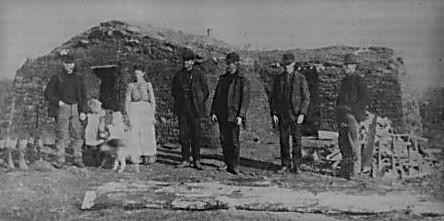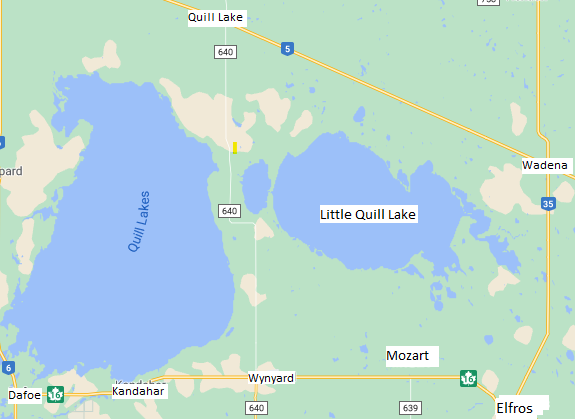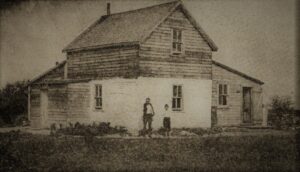
Ólafur Stefánsson´s hut was built 3 miles south of Wynyard in 1904. It was the first home in the settlement.
Four settlers arrived in the Wynyard district late in the summer of 1904. Ólafur Stefánsson (Olafur Stephansson) emigrated from Iceland in 1898 and spent a few years in N. Dakota before heading northwest. Magnús Guðmundsson Ísfeld (Magnus G Isfeld) brought his large family from Brazil and homesteaded halfway between Mozart and Wynyard, Guðmundur Þórarinsson (Gudmundur Thorarinsson) and Jón Jónsson (John Johnson) from Eyjafjarðarsýsla, his wife Guðný Eiríksdóttir and their son Jón Frímann (John F. Johnson) homesteaded and immediately started work on building cabins, stables, and barns. They had some animals, so they cut some hay for the winter. All had some farming experience in America, either they had homesteaded before or worked for others. Such was not the case with Jón Jónsson (John Johnson Westdal), his wife Anna Gunnlaugsdóttir and their children who arrived from Iceland in the summer of 1904. After several months in Argyle, Manitoba, they headed northwest in November and homesteaded. Ólafur Oddsson (Olafur O. Magnusson) from Dalasýsla described their arrival in an article in Almanak in 1950: “It requires daring and courage to settle with a wife and children on wild land in a strange country and, without shelter, attack a Canadian winter. Fortunately, some of the children were grown up or nearly so. The first task was to put up a shelter. That was done on the Icelandic pattern – sod was dug, and rails used for rafters. But the main supports for the building had to be carried a long distance, because there were no draft animals.” (transl.Walter Lindal).
Five young men arrived that same fall from N. Dakota, among them three brothers. These were Steingrímur, Kristinn, and Jón, sons of Brynjólfur Jónsson, who immediately built one shack. The other two were Ole J. Jónasson, (Jónas Ólafur), son of Jóhannes Jónasson from Skagafjörður, and Sigurjón J. Wium, son of Jón Björnsson and Guðrún Jónsdóttir who emigrated from Iceland in 1876. These two brought with them a small number of cattle and some horses. They had been there in the summer and cut hay for the animals but now spent all their efforts on making shelter for the animals. Once done they made a dugout for themselves, covered it with canvas and later snow.
 Around the turn of the century, settlements in the Icelandic communities were overpopulated, some farms were too small to sustain the number of people, families and workers. Young men starting families had to look elsewhere and when news reached N. Dakota that a vast area west of Manitoba was opening up for farmers, discussions on a move to the northwest began. Meetings were held in the early 1904 where it was agreed to send a delegation to explore the new region. The group consisted of Halldór Jónatansson, (Halldor J. Halldorsson), Óli J. Halldórsson (Oli J. Halldorson) son of Jóhannes Halldórsson and Anna Sigurðardóttir, Ólafur Oddsson (Olafur O. Magnusson), son of Oddur Magnússon from Dalasýsla, Ásgeir Guðjónsson (Asgeir Gudjonson) from S. Þingeyjarsýsla and Bjarni Friðriksson (Bjarni F. Bjarnason) son of Friðrik Bjarnason from Húnavatnssýsla. They headed for Foam Lake and once there, they met Tómas Þórðarson (Thomas Paulson) who suggested an area as far west as the Big Quill Lake. They selected the area south of Little Quill Lake, slightly higher in elevation than the area further west, as they felt this was better suited for mixed farming. On their way back, they stopped at Yorkton to file homestead papers for themselves and others in N. Dakota.
Around the turn of the century, settlements in the Icelandic communities were overpopulated, some farms were too small to sustain the number of people, families and workers. Young men starting families had to look elsewhere and when news reached N. Dakota that a vast area west of Manitoba was opening up for farmers, discussions on a move to the northwest began. Meetings were held in the early 1904 where it was agreed to send a delegation to explore the new region. The group consisted of Halldór Jónatansson, (Halldor J. Halldorsson), Óli J. Halldórsson (Oli J. Halldorson) son of Jóhannes Halldórsson and Anna Sigurðardóttir, Ólafur Oddsson (Olafur O. Magnusson), son of Oddur Magnússon from Dalasýsla, Ásgeir Guðjónsson (Asgeir Gudjonson) from S. Þingeyjarsýsla and Bjarni Friðriksson (Bjarni F. Bjarnason) son of Friðrik Bjarnason from Húnavatnssýsla. They headed for Foam Lake and once there, they met Tómas Þórðarson (Thomas Paulson) who suggested an area as far west as the Big Quill Lake. They selected the area south of Little Quill Lake, slightly higher in elevation than the area further west, as they felt this was better suited for mixed farming. On their way back, they stopped at Yorkton to file homestead papers for themselves and others in N. Dakota.
They brought the good news back to N. Dakota in late summer and almost immediately preparations began for the move to the new settlement west of Manitoba. During the fall and winter, farmers who were determined to move worked diligently at the preparations. In the spring it was clear that the exodus from N. Dakota would be in two groups. One would depart in the spring of 1905, the second a year later. A special train had been rented from the Canadian National Railroad (C.N.R.), the first two coaches were filled with people while 36 box cars were loaded with livestock and personal effects. On May 23, 1905, the train stopped at the station in Wadena which was as far as the train went. A year later, the second group from N. Dakota travelled further west to the station in Quill Lake, the third station beyond Wadena. The distance to the settlement from Wadena was just under 50 km (31 miles) and under 40 (25 miles) from the Quill Lake station. People covered the distance on foot, carrying their belongings and driving the animals. Once on the site, settlement commenced in earnest.

Halldór´s house was built in 1905 some 8 miles from Wynyard, Photo SI
The new settlement corresponded with the birthyear of Saskatchewan which officially became a province September 1, 1905. Halldór Jónatansson must be considered the “father” of the Wynyard settlement; he had led the exploration committee in the spring of 1904 which choose the area, and he was the first to build a home. He opened a store on his property as well as a post-office which was given the name Sleipnir. The period 1905-1907 saw nearly all available land in the area homesteaded. A year later the Canadian Pacific Railroad (C.P.R.) railway reached the settlement and a new station was opened called Wynyard.
English version by Thor group.
